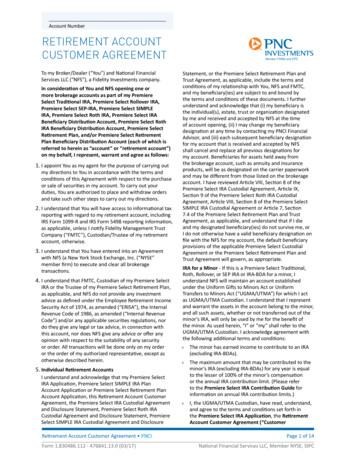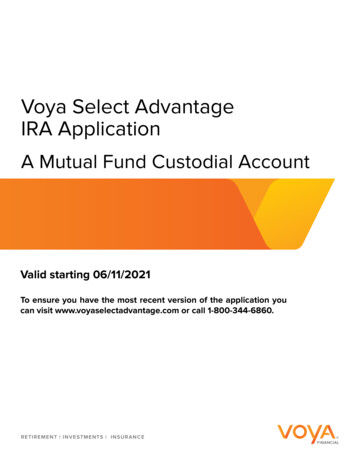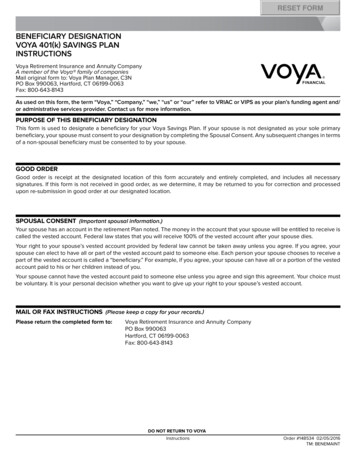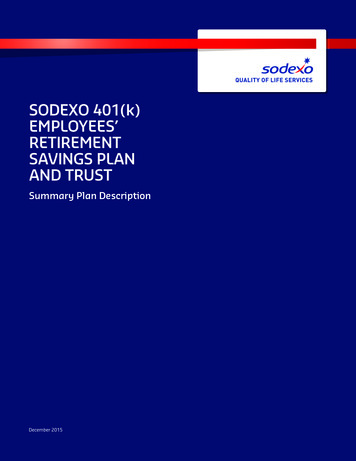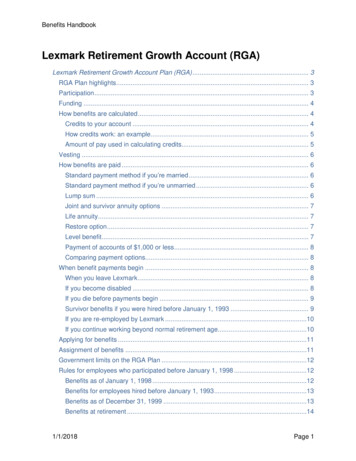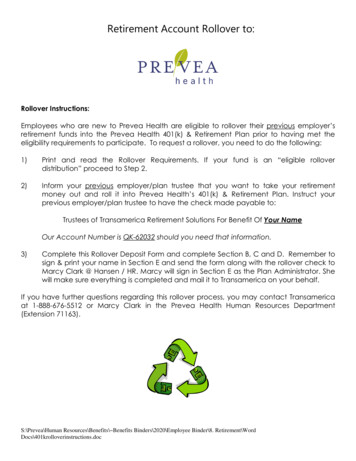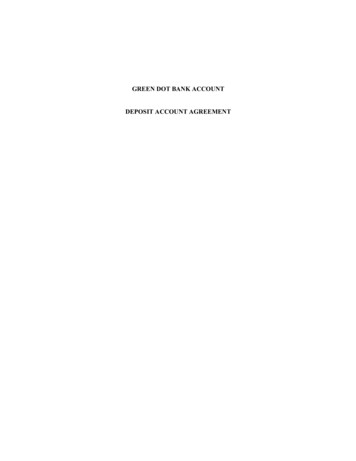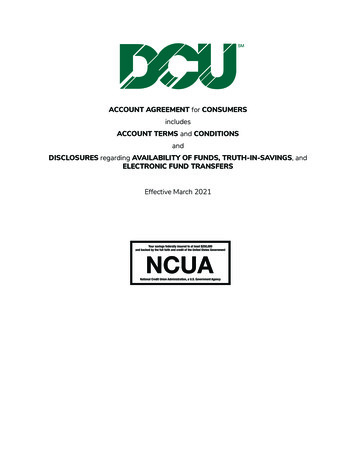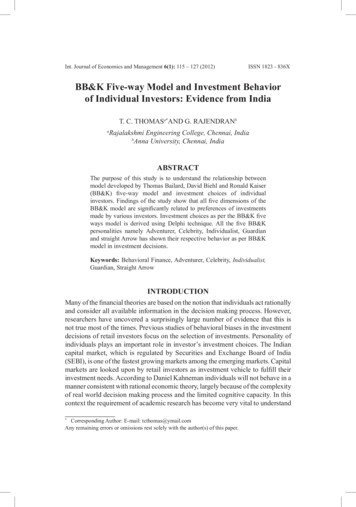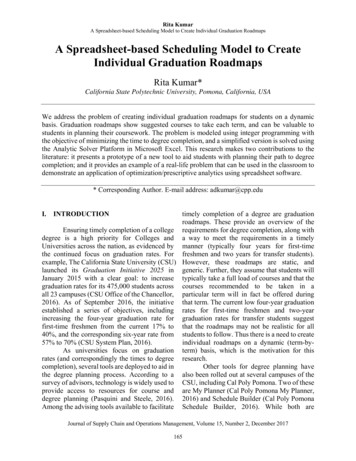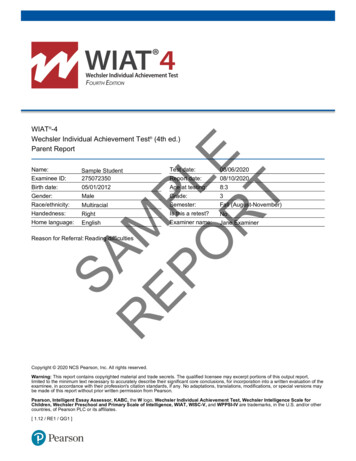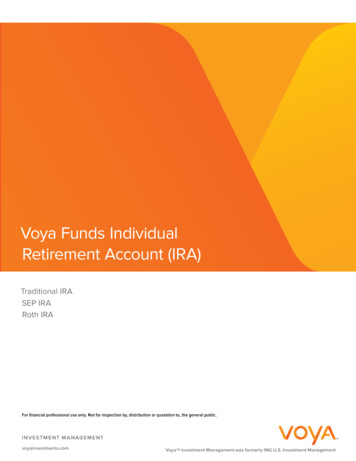
Transcription
Voya Funds IndividualRetirement Account (IRA)Traditional IRASEP IRARoth IRAFor financial professional use only. Not for inspection by, distribution or quotation to, the general public.I N V E S T M E N T M A N AG E M E N Tvoyainvestments.comVoyaTM Investment Management was formerly ING U.S. Investment Management
BNY MELLON INVESTMENT SERVICING TRUST COMPANYSupplement to the Traditional and Roth Individual Retirement Account (IRA)Disclosure Statement for Tax Year 2020DEADLINE FOR 2019 CONTRIBUTIONS TO A TRADITIONAL OR ROTH IRA:On March 20, 2020, the Internal Revenue Service (the “IRS”) issued Notice 2020-18 (the “Notice”) in response to the ongoing Coronavirus pandemic. TheNotice extends the deadline for individuals to make 2019 contributions to traditional IRAs and Roth IRAs to July 15, 2020. For more information pleaserefer to the Internal Revenue Service (IRS) web site: www.irs.gov.2020 IRA CONTRIBUTION LIMITS FOR TRADITIONAL AND ROTH IRA:The maximum allowable contribution to your IRAs (deductible, non-deductible, and Roth) for the tax year remains unchanged and is the lesser of (a) 6,000 or (b) 100% of your earned income. For those who have attained or will attain the age of 50 before the close of the taxable year, the annual IRAcontribution limit is increased by 1,000 (total of 7,000 for 2020). Any contribution made to your IRA will be treated as a current year contributionrecorded in the year it is received, unless the contribution is made between January 1 and April 15, 2020, and you have identified the contribution as aprior year contribution. Please consult IRS Publication 590-A Contributions to Individual Retirement Arrangements (IRAs) for eligibility requirements andcontribution restrictions.2020 TRADITIONAL IRA INCOME TAX DEDUCTION:Your contribution to a traditional IRA may be deductible on your federal income tax return. However, there is a phase-out of the IRA deduction if you arean active participant in an employer-sponsored retirement plan. The IRA deduction is reduced proportionately as modified adjusted gross incomeincreases. If you are not an active participant in an employer-sponsored retirement plan, there is a phase-out of the IRA deduction if you’re married basedon whether or not your spouse is covered by a workplace retirement plan. Please consult IRS Publication 590-A Contributions to Individual RetirementArrangements (IRAs) for assistance in calculating your deductible contribution as it pertains to individual income and employer-sponsored retirement plancircumstances. Your contribution in excess of the permitted deduction will be considered a non-deductible contribution.DEDUCTION LIMIT - Effect of Modified AGI on Deduction – Covered by a Retirement Plan at WorkTAX YEAR 2020Full deduction ifmodified AGI is:Partial deduction ifmodified AGI is:No deduction ifmodified AGI is:Single Filers or Head of Household 65,000 or lessMore than 65,000but less than 75,000 75,000 or moreMarried - filing jointly or Qualified Widow(er) 104,000 or lessMore than 104,000but less than 124,000 124,000 or moreMarried - filing separatelyN/ALess than 10,000 10,000 or moreDEDUCTION LIMIT - Effect of Modified AGI on Deduction – You are NOT Covered by a Retirement Plan at Work (Spousal Coverage Considered)TAX YEAR 2020Full deduction ifmodified AGI is:Partial deduction ifmodified AGI is:No deduction ifAGI is:Married - filing jointly - spouse coveredat work 196,000 or lessMore than 196,000but less than 206,000 206,000 or moreMarried - filing separately - spouse coveredat workN/ALess than 10,000 10,000 or more2020 ROTH IRA CONTRIBUTION ELIGIBILITY:For 2020, your Roth IRA contribution limit is reduced (phased out) based on your modified AGI as follows:TAX YEAR 2020Full contribution ifmodified AGI is:Partial contribution ifmodified AGI is:No contribution ifAGI is:Married - filing jointly or Qualified Widow(er) 196,000 or lessMore than 196,000but less than 206,000 206,000 or moreMarried - filing separatelyN/Aless than 10,000 10,000 or moreSingle, Head of Household or Married - filingseparately and you did not live with yourspouse at any time during the yearLess than 124,000At least 124,000but less than 139,000 139,000 or moreThese limits may be adjusted from time to time by the IRS; please refer to Publication 590-A Contributions to Individual Retirement Arrangements (IRAs)for current year limits.
REQUIRED FEDERAL INCOME TAX WITHHOLDING ON ESCHEATED TRADITIONAL IRA ACCOUNTS:Effective as of January 1, 2020, for any Traditional IRA that becomes dormant and subject to escheatment under state unclaimed property law, the InternalRevenue Service requires reporting of the amount escheated on IRS Form 1099R and income tax withholding at the time of escheatment to the state. Youagree and authorize the Custodian to liquidate sufficient assets in your custodial account to provide for the withholding to the IRS. The Custodian willremit withholding to the IRS in accordance with any prior withholding election. If you have not made a prior withholding election, the Custodian will remitwithholding at a rate of ten percent (10%).INCOME TAX WITHHOLDING:Also, as noted above, effective as of January 1, 2020, for any Traditional IRA that becomes dormant and subject to escheatment under state unclaimedproperty law, the Internal Revenue Service requires reporting of the amount escheated on IRS Form 1099R and income tax withholding at the time ofescheatment to the state. You agree and authorize the Custodian to liquidate sufficient assets in your custodial account to provide for the withholding tothe IRS. The Custodian will remit withholding to the IRS in accordance with any prior withholding election. If you have not made a prior withholdingelection, the Custodian will remit withholding at a rate of ten percent (10%).CHANGES TO COMPLY WITH IRS NOTICE 2020-23:On April 9, 2020, the Internal Revenue Service (“IRS”) issued Notice 2020-23, which provides an extension to July 15, 2020 for certain time sensitive filingsand actions, provided the due date for such filings and actions falls on or after April 1, 2020 and before July 15, 2020. This extension includes, but is notlimited to, the following filings and time-sensitive actions:1.Filing Form 5498 for contributions to an Individual Retirement Account (“IRA”), Coverdell Education Savings Account, and Health SavingsAccount;2.Removing excess deferrals made to a qualified plan or excess contributions to an IRA, provided the original due date for removing theexcess deferral or contribution was on or after April 1, 2020 and before July 15, 2020;3.Completing a 60-day rollover of funds between eligible qualified retirement plans or IRAs, provided the original due date of the rolloverwas on or after April 1, 2020 and before July 15, 2020.Notice 2020-23 expands the relief provided by the CARES Act for IRA owners who received an RMD on or after February 1, 2020. Those individuals willhave until July 15, 2020 to roll the RMD back into an IRA. However, Notice 2020-23 does not provide relief for IRA owners who received their RMD duringJanuary, 2020 due to the requirement that rollovers be completed within 60 days of receipt of the distribution.Additionally, Notice 2020-23 does not provide relief from the “one IRA to IRA rollover per year” rule that applies to individual IRA owners. IRA owners whopreviously completed an IRA to IRA rollover of a distribution taken within the previous 12 months cannot do a second rollover.CHANGES TO COMPLY WITH THE CARES ACT:REQUIRED MINIMUM DISTRIBUTION WAIVERS FOR 2019 AND 2020 UNDER THE CARES ACT:In response to the ongoing Coronavirus pandemic, the Coronavirus Aid, Relief, and Economic Security Act (the “CARES Act”) was signed into law on March27, 2020. Under the CARES Act, Required Minimum Distributions (“RMDs”) for 2019 are waived for those individuals who reached age 70 ½ in 2019 andwho elected to defer their first RMD until April 1, 2020. In addition, RMDs for 2020 are waived for all individuals who would normally have an RMD due byDecember 31, 2020. This includes IRA beneficiaries who elected or are required to take Life Expectancy Distributions.ROLLOVERS OF 2020 RMDS ARE PERMITTED UNDER THE CARES ACT:Distributions from qualified plans and IRAs made in 2020 that would normally be considered an RMD may be rolled over into an eligible retirement plan orIRA, provided the distribution would otherwise be an “eligible rollover distribution”. In that case, the following regular rollover rules still apply: a) thedistributed proceeds must be rolled over to an eligible retirement plan or IRA within 60 days of receipt of the distribution; and b) for an IRA to IRA rollover,the individual cannot have completed an IRA to IRA rollover within the previous 12 months.TREATMENT OF IRA BENEFICIARIES SUBJECT TO THE 5-YEAR RULE UNDER THE CARES ACT:For IRA beneficiaries who are subject to the 5-year distribution rule, the year 2020 will be disregarded for purposes of applying the 5-year distribution rule.CORONAVIRUS-RELATED DISTRIBUTIONS:The CARES Act permits Coronavirus-Related Distributions from IRAs and retirement plans including 401(k) plans, 403(b) plans, and governmental 457(b)plans. These distributions must be taken in 2020 and cannot exceed 100,000. The following individuals are eligible to take a Coronavirus-RelatedDistribution: Individuals who have been diagnosed with “the virus SARS-CoV-2” or “coronavirus disease 2019 (COVID-19)”; individuals whose spouse ordependent is diagnosed with such virus or disease, and individuals who experience adverse financial consequences as a result of:oooobeing quarantined, furloughed or laid off or having reduced working hours due to the virus/disease,being unable to work due to lack of child care due to the virus/disease,closing or reducing hours of a business owned or operated by the individual due to the virus/disease, orother factors as determined by Treasury.The following temporary tax relief will apply to Coronavirus-Related Distributions:
Coronavirus-Related Distributions to individuals under age 59 ½ will not be subject to a 10% early withdrawal penalty.Coronavirus-Related Distributions from qualified plans, 401(k) plans, 403(b) plans will not be treated as an eligible rollover distribution and,therefore, will not be subject to the mandatory 20% Federal tax withholding.Coronavirus-Related Distributions may be repaid in multiple payments over a three year period beginning on the day the distribution wasreceived. The repayments must be in the form of a rollover to a qualified plan or an IRA account that can accept rollovers. These repaymentsare not subject to the one rollover per 12 month rule or the rule that requires rollovers within 60 days.Coronavirus-Related Distributions that must be reported as taxable income may be included in an individual’s 2020 taxable income, or if theindividual so elects, may be spread equally over a three-year period.CHANGES TO COMPLY WITH THE SECURE ACT:TRADITIONAL and ROTH INDIVIDUAL RETIREMENT ACCOUNTCOMBINED DISCLOSURE STATEMENTCONTRIBUTIONSFor 2020, the maximum allowable contribution to your individual retirement accounts (deductible, non-deductible, and Roth) is the lesser of (a) 6,000 or(b) 100% of your earned income. If you are submitting a prior year contribution, the limit was set at 6,000.Age 50 or above catch-up contributions – For those who have attained the age of 50 before the close of the taxable year, the annual IRA contribution limitis increased by 1,000.For tax years after 2020, the above limits may be subject to IRS cost-of-living adjustments, if any. Please read the Traditional and Roth IndividualRetirement Account Combined Disclosure Statement carefully or consult IRS Publication 590 or a qualified tax professional for more information abouteligibility requirements and contribution restrictions. TRADITIONAL IRA CONTRIBUTION RESTRICTION - Effective as of January 1, 2020, the maximum age of 70 ½ for traditional IRA contributionshas been repealed. Beginning in 2020, IRA owners who have reached age 70 ½, or older, may make a contribution, provided they have earnedincome for the year. This change does not allow owners over the age of 70 ½ to make a 2019 or prior contribution, however. ROTH IRA CONTRIBUTION - There is no age restriction for contributions to a Roth IRA, as long as the requirements of earned income are met.TRADITIONAL INDIVIDUAL RETIREMENT ACCOUNT DISCLOSUREYou have opened an IRA, which is a traditional or SEP IRA for the exclusive benefit of you and your beneficiaries, created by a written instrument (theCustodial Account Agreement). The following requirements apply to your IRA:6. You must begin receiving distributions from your account no later than:i.ii.iii.April 1 of the year following the year in which you attain age 70½; if you attained age 70 ½ in or prior to 2019 (those owners born on or prior toJune 30, 1949)April 1 of the year following the year in which you attain age 72; if you attain age 70 ½ in or after 2020 (those owners born on or after July 1,1949)and distributions must be completed over a period that is not longer than the joint life expectancy of you and your beneficiaryTRADITIONAL IRA ELIGIBILITYYou are permitted to make a regular contribution to your traditional IRA for any taxable year, if you receive compensation for such taxable year. For taxyear 2019 and prior, contributions were not allowed for any year in which or after you attained age 70 ½. Compensation includes salaries, wages, tips,commissions, bonuses, alimony, royalties from creative efforts and “earned income” in the case of self-employment, payments made to individualspursuing graduate or post-doctoral study or research and Difficulty of Care Payments. The amount which is deductible depends upon whether or not youare an active participant in a retirement plan maintained by your employer; your modified adjusted gross income; your marital status; and your tax filingstatus.EARLY DISTRIBUTIONS FROM A TRADITIONAL IRAYour receipt or use of any portion of your account (excluding any amount representing a return of non-deducted contributions) before you attain age 59½is considered an early or premature distribution. The distribution is subject to a penalty tax equal to 10% of the distribution unless one of the followingexceptions applies to the distribution:3.used specifically for deductible medical expenses which exceed 10% of your adjusted gross income, or10. the distribution is in aggregate 5,000 or less and is taken within the 1 year period beginning on the date on which a child of the individual is born oradopted as defined in section 72(t)(2) of the Internal Revenue Code.
REQUIRED DISTRIBUTIONS FROM A TRADITIONAL IRAYou are required to begin receiving minimum distributions from your IRA by your required beginning date, which is defined as:a. April 1 of the year following the year in which you attain age 70½; if you attained age 70 ½ in or prior to 2019 (those owners born on or prior to June30, 1949), orb. April 1 of the year following the year in which you attain age 72; if you attain age 70 ½ in or after 2020 (those owners born on or after July 1, 1949)The year you attain age 70 ½ or 72, as applicable, is referred to as your "first distribution calendar year". Your required minimum distribution for each year,beginning with the calendar year you attain age 70 ½ or 72, as applicable, is generally based upon the value of your account at the end of the prior yeardivided by the factor for your age (derived from the IRS Uniform Lifetime Distribution Period Table). This table assumes you have a designated spousebeneficiary exactly 10 years younger than you. However, if your spouse is your sole beneficiary and is more than 10 years younger than you, your requiredminimum distribution for each year is based upon the joint life expectancies of you and your spouse. The account balance that is used to determine eachyear's required minimum distribution amount is the prior year end fair market value (value as of December 31st), adjusted for outstanding rollovers,transfers and recharacterizations (that relate to a conversion or failed conversion made in the prior year). You are responsible for notifying the Custodianof any outstanding amounts.TRADITIONAL IRA DISTRIBUTIONS DUE TO DEATH OF AN IRA OWNER WHEN THE DATE OF DEATH IS ON OR PRIOR TO DECEMBER 31st, 2019If, prior to your death, you have not started to take your required distributions and you have properly designated a beneficiary(ies), the entire value ofyour IRA must be distributed to your beneficiaries within five years after your death, unless the designated beneficiary elects in writing, no later thanSeptember 30th of the year following the year in which you die, to take distributions over their life expectancy. These distributions must commence nolater than December 31st of the calendar year following the calendar year of your death. However, if your spouse is your sole beneficiary, thesedistributions are not required to commence until the December 31st of the calendar year you would have attained age 70½, if that date is later than therequired commencement date in the previous sentence. If you die before your required beginning date and you do not have a designated beneficiary, thebalance in your IRA must be distributed no later than the December 31st of the calendar year that contains the fifth anniversary of your death.If you die on or after your required beginning date and you have a designated beneficiary, the balance in your IRA will be distributed to your beneficiaryover a period not longer than the beneficiary's single life expectancy. These distributions must commence no later than December 31st of the calendar yearfollowing the calendar year of your death. If you die on or after your required beginning date and you do not have a designated beneficiary, the balance inyour IRA must be distributed over a period that does not exceed your remaining single life expectancy determined in the year of your death. However, therequired minimum distribution for the calendar year that contains the date of your death is still required to be distributed. Such amount is determined asif you were still alive throughout that year. If your spouse is your sole beneficiary, your spouse may elect to treat your IRA as their own IRA, whether youdie before or after your required beginning date. If you die after your required beginning date and your spouse elects to treat your IRA as his or her ownIRA, any required minimum that has not been distributed for the year of your death must still be distributed to your surviving spouse and then theremaining balance can be treated as your spouse's own IRA. After your death, your designated beneficiary may name a subsequent beneficiary. Anysubsequent beneficiaries must take distributions at least as frequently as the original designated beneficiary, provided the original beneficiary’s date ofdeath is on or prior to December 31st , 2019. If you do not properly designate a beneficiary, or all designated beneficiaries have predeceased you, yourspouse shall become the beneficiary or, if no surviving spouse or unmarried, the distribution will be made to your estate.TRADITIONAL IRA DISTRIBUTIONS DUE TO DEATH OF AN IRA OWNER WHEN THE DATE OF DEATH IS ON OR AFTER JANUARY 1, 2020If you die on or after your required beginning date the required minimum distribution for the year of your death must be distributed to yourbeneficiary(ies) if it has not otherwise been taken prior to the date of your death. If you have one or more properly designated beneficiaries, all otheramounts remaining in your IRA upon your death must be distributed no later than December 31st of the calendar year that contains the tenth anniversaryof your death. If you have no designated beneficiary by September 30th of the year following the year in which you die, the entire value of your IRA mustbe distributed to your beneficiaries
2014 Voya Investments Distributor, LLC 230 Park Ave, New York, NY 10169 INVESTMENT MANAGEMENT voyainvestments.com VoyaTM Investment Management was formerly ING U.S. Investment Management For financial professional use only. Not for inspection by, distribution or quotation to, the general public. Voya Funds Indi
